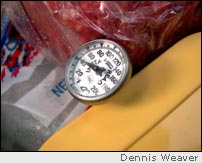Road
Food: Articles by Dennis Weaver
More Road Food articles>
Cooler
Cuisine:
It always begins with a deep-down, gurgling rumble. Then you get sick, sometimes very sick -- like "let's-go-to-the hospital" sick. Even if you are over it in 24 hours, this is not what you want to do on a road trip. But thousands do, and it could be you. You don't have to be a casualty. A thermometer, a few chuck wagon road rules, and a basic knowledge of which foods are the most hazardous and you can avoid the dastardly occurrence of food poisoning on the road. In this article, we'll tell you how with road rules and an overview of how to keep those foods that you packed safe. There are three types of microorganisms that might make us sick: yeasts, molds, and bacteria. We are surrounded by all three--they are in the air, the soil, and the water. We cannot avoid them entirely, but we can control their growth. Bacteria are the big, bad bullies on the block and are far tougher than molds and yeasts. The three bacteria strains that typically cause food poisoning are salmonella, staphylococcus, and botulism. All require a moist environment to grow, and between 50 degrees and 140 degrees Fahrenheit, the bacteria load can grow at a staggering rate. Under these conditions, foods with minimal contamination can be dangerously loaded with bacteria in just a few hours. Dry foods are safe, but moist foods, particularly meats and dairy products, carry bacteria -- especially staphylococcus. Botulism is the most toxic -- the poison thrown off by botulism is so powerful that a single teaspoon of toxin could kill thousands of people. Bacteria and molds can be contained with temperatures. Bacteria are inactive or nearly so at temperatures below 40 degrees. Temperatures above 145 degrees begin to kill bacteria. Molds don't grow below 32 degrees and they die above 140 degrees. Keep cold foods below 40 degrees and hot foods above 145. So with that quick background, here are our road rules:
Now as a practical matter, how long can you keep that food in the cooler? More on Page 2>
|


 Dennis
Weaver -- having burnt food from Miami, Florida
to Point Barrow, Alaska -- is RTA's road food expert.
He has logged thousands of hours on the roads, trails,
and waterways of America including many of Alaska's
wilderness rivers and has consistently been elected
the trips' "chief cook and bottle washer."
Dennis is currently general manager at
Dennis
Weaver -- having burnt food from Miami, Florida
to Point Barrow, Alaska -- is RTA's road food expert.
He has logged thousands of hours on the roads, trails,
and waterways of America including many of Alaska's
wilderness rivers and has consistently been elected
the trips' "chief cook and bottle washer."
Dennis is currently general manager at